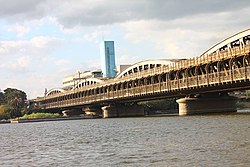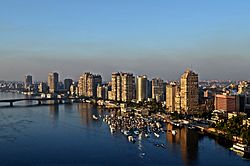Imbaba
Imbaba إمبابة | |
|---|---|
 An old photo of the Imbaba bridge | |
| Coordinates: 30°5′33″N 31°12′2″E / 30.09250°N 31.20056°E | |
| Country | |
| Governorate | Giza Governorate |
| Area | |
• Total | 8.28 km2 (3.20 sq mi) |
| Population | |
• Total | 1,465,875 |
| • Density | 180,000/km2 (460,000/sq mi) |
| approximately | |
| Time zone | UTC+2 (EST) |
Imbaba (Arabic: إمبابة Imbāba, IPA: [emˈbæːbæ]) is a working-class neighbourhood in northern Giza, Egypt, located west of the Nile and northwest of and near Gezira Island and downtown Cairo, within the Giza Governorate. The district is located in the historic upper Nile Delta, and is part of the Greater Cairo metropolitan area. Imbaba is the most densely populated city subdivision in the world.
Imbaba is also the name of an adjacent administrative centre (مركز) in rural Giza Governorate, which has 18 villages in its jurisdiction.[1]
Etymology
[edit]The origin of the name Imbaba is not certain. Some sources claim that it comes from the Amharic word for African fan palm (Amharic: ዘምባባ, romanized: zembaba) and that the area was called so by Ethiopian camel merchants and herders to describe the place where they met to do business.[1]
However, the fan palm does not grow in Egypt[2] and older versions of the name that do not correspond to the Amharic word are attested – Nababa (Arabic: نبابة)[3] and Ambuba (Arabic: امبوبه).[4]
History
[edit]For centuries Imbaba was the final destination for camels brought from as far as Sudan and the Horn of Africa, to be sold in the village's Friday market. The market still exists, but is no longer as important as it was up to the turn of the 20th Century due to increasing urbanisation.[5][6]
A map created by the General Authority for Physical Planning in 2012, shows details of areas within Imbaba which were unplanned, and that at the time, were considered unsafe. Imbaba is densely populated.[7][1]
Pigeon breeding is a favorite activity of some of the neighborhood residents with access to rooftops.[8][9]
Battle of the Pyramids
[edit]The Battle of the Pyramids, also known as the Battle of Embabeh, was a battle fought on July 21, 1798, between the French army in Egypt under Napoleon Bonaparte, and local Mamluk forces. It occurred during France's Egyptian Campaign and was the battle where Napoleon put into use one of his significant contributions to tactics, the massive divisional square. Napoleon named the battle after the Egyptian pyramids, although they were only faintly visible on the horizon when the battle took place.
Siege of Imbaba
[edit]In late 1992, the "Islamic Group" (al-Gama'a al-Islamiyya) expanded its influence in parts of Imbaba. In November, the group purportedly announced the establishment of the "Emirate of Imbaba" (some accounts claim that foreign news media coined the term, not the group itself). This challenge to the sovereignty of the Egyptian state triggered the siege of Imbaba, beginning on December 8. In its course, the government deployed over 12,000 police and state Security forces, along with one hundred personnel carriers and bulldozers, all of which put an end to the Emirate.[10][11][12]
Imbaba's districts
[edit]- Madinat Al-Umal
- Bashtil
- Madinat Al-Tahrir
- Al-Muniera
- Ard Al-Gameya
Notable people
[edit]- Ali El Haggar – singer
- Mohamed Henedi – actor
- Ibrahim Youssef – soccer player
- Ismail Youssef – soccer player
- Mohamed Esmat – Aviation Industry
See also
[edit]References
[edit]- ^ a b c d "Imbaba". tadamun.co.
- ^ "Borassus aethiopum Mart. | Plants of the World Online | Kew Science". Plants of the World Online. Retrieved 2023-02-23.
- ^ al-Idrisi. Nuzhat al-mushtaqft ikhtirdq al-afdq.
- ^ "Ministry of Finance, Egypt - Atlas of Egypt: Lower and Upper Egypt (1914)". Paths - the Archaeological Atlas of Coptic Literature.[permanent dead link]
- ^ Cowell, Alan (18 December 1989). "Imbaba Journal; Camels and Men: All Is Changing and Unchanged". NYT.
- ^ Khater, Akram (November 1989). "Imbaba". Saudi Aramco World. 40 (6): 36–40.
- ^ "Unplanned and Unsafe Areas in Imbaba map". tadamun.co.
- ^ Metcalfe, John (22 July 2014). "The Rooftop Homes of Cairo's Racing Pigeons". City Lab. Retrieved 11 December 2018.
- ^ Blechman, Andrew (2011). "Cairo's Fancy Fliers". Saudi Aramco World. Vol. 62, no. 2. Aramco Services Company. p. 9. Retrieved 11 December 2018.
- ^ Singerman, Diane. “The Siege of Imbaba, Egypt’s Internal ‘Other,’ and the Criminalization of Politics.” In Cairo Contested: Governance, Urban Space, and Global Modernity, ed. Diane Singerman, 111-144. New York, NY: The American University in Cairo Press, 2009. Pages 112-114.
- ^ "Church burning deepens tumult of Egypt transition". Fox News. Cairo. Associated Press. 8 May 2011. Retrieved 9 May 2011.
Islamic extremists declared the crowded district a state within a state in the 1990s, calling it "the Islamic Republic of Imbaba," one of the country's hottest spots of Islamic militancy.
- ^ Lindsey, Ursula (4 March 2010). "And then Cairo turned itself inside out". The National. Retrieved 9 May 2011.
At around the same time, the Islamist group Jama'a Islamiya took de facto control of Imbaba - creating what the foreign press quickly dubbed 'the Islamic Republic of Imbaba'. The government dispatched more than 12,000 soldiers to carry out a six-week siege, round up the Islamists, and reimpose its authority.
External links
[edit]- "Few Focus on Religion in One Cairo Neighborhood" by Anthony Shadid, New York Times February 15, 2011.


 French
French Deutsch
Deutsch

